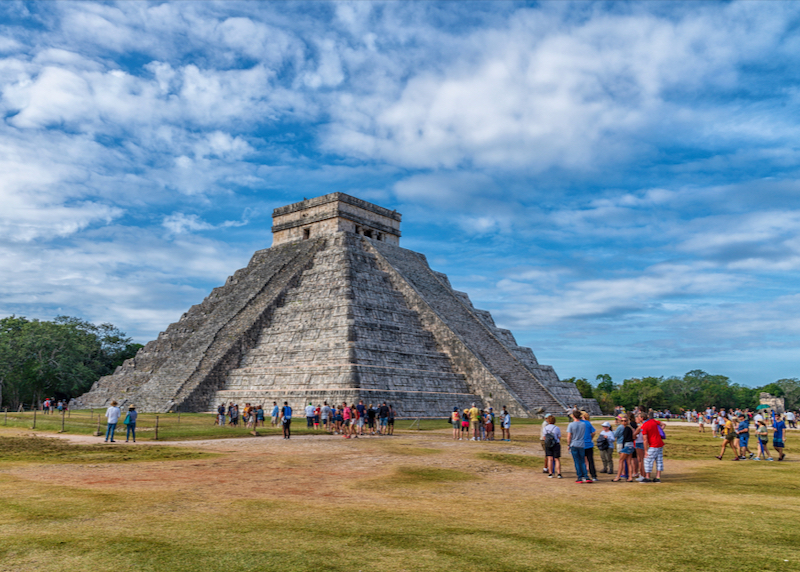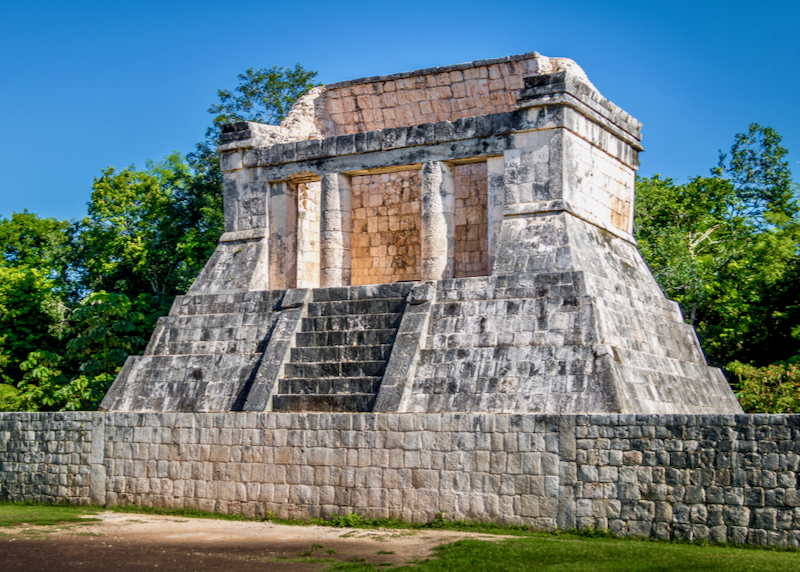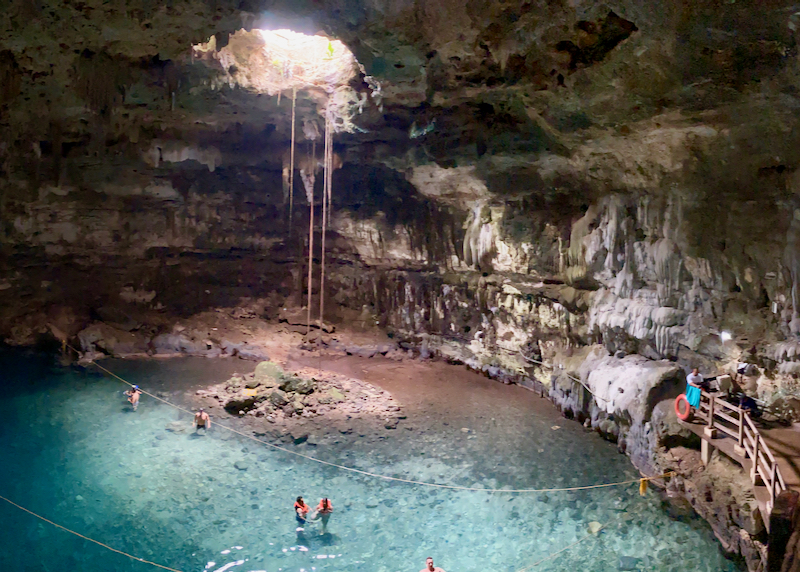Mexico › Chichen Itza
Updated: March 1, 2022
See Also
Chichén Itzá, a UNESCO World Heritage Site, is one of the most spectacular archeological sites in Mexico, and also one of the most easily accessible.

El Castillo (The Castle), known as the Temple of Kukulcán is the main pyramid at the center of Chichen Itza.
Frequently Asked Questions about Chichén Itzá
Where is Chichén Itzá?
Chichén Itzá is a Maya archeological site, located in the Mexican state of Yucatán, in the northern part of the Yucatán Peninsula. Chichén Itzá lies around 120 km east of Yucatán state capital Mérida, 200 km west of Cancún, and around 1420 km northeast of Mexico City (by road).
How big is Chichén Itzá?
The core site of Chichén Itzá covers around 5 square kilometers (1.9 square miles), though smaller houses (as yet unexcavated) are thought to have existed far beyond these boundaries (at least 10 square kilometers or 4 square miles). The area open to tourists today is around 100 acres. At its peak some 35,000 people would have lived here, but the nearest settlement today is the village of Pisté, 2 km to the northwest.
What is the history of Chichén Itzá?
Chichén Itzá was one of the last great Maya cities to develop, founded around 300 AD and flourishing from the early 10th century. It began to decline sometime in the 11th century for reasons that are still unknown, though a sizeable Maya community was still living in or around the city when the Spanish arrived in the 1520s. Conquistador Francisco de Montejo the Younger briefly conquered the land around Chichén Itzá in 1532, and renamed the city “Ciudad Real”, but was driven out by the Maya in 1535 – his conquest wasn’t complete until the late 1540s. Thereafter Chichén Itzá was completely abandoned, the land around it given up to cattle ranches. American explorer John Lloyd Stephens visited Chichén Itzá in the early 1840s and wrote about the ruins, initiating modern interest in the site. Large-scale excavation and restoration began in the 1920s, and the site was opened to tourists.
How do I get to Chichén Itzá?
Most tourists visit Chichén Itzá from Cancún (which has numerous flights to the US and Canada), or the nearby resorts of the “Riviera Maya”, though the airport at Mérida is closer (flights to Mérida take just 1 hour 45 minutes from Mexico City).
Taking a organized tour (with transport by bus included) is the most convenient option and is easy to arrange at hotels in the region, but this will entail an early start, several hours on the bus, and will mean arriving at Chichén Itzá at the same time as potentially many other tour groups.
It’s also relatively straightforward to visit independently – allowing more flexibility and more time at Chichén Itzá. Taxis to Chichén Itzá from Mérida Airport cost around 1500 pesos or US$75 one way, and take just 1.5 hours. From Cancún taxis take at least 2 hours 30 minutes, and will charge much more – US$250 one-way. It’s much cheaper to rent a car (see below) or take a public bus.
It’s possible to take first-class buses direct to the ruins at Chichén Itzá – much cheaper than taking a guided tour. Buses from Cancún take just over 3 hours.
Remember that Cancún and the Caribbean coast of the Yucatán is one hour ahead (EST) of Chichén Itzá (CST).
How much does the Chichen Itza entrance ticket cost?
The entrance fee at Chichen Itza is: $481 Pesos per adult. Kids under 13 years are admitted free.
What about Uber?
Uber is available in Mérida and Cancún but the app won’t allow trips as far as Chichén Itzá – negotiate with regular taxi drivers instead.
Can I drive to Chichén Itzá?
Driving from the Caribbean coast resorts such as Cancún, Playa del Carmen, Tulum or from Mérida, is straightforward and safe – the toll roads are well-maintained and not especially busy. We recommend RentalCars.com which helps you to locate a rental near to where you’re staying.
Driving all the way from the US is possible but not recommended. It’s over 1300 miles (2092 km) from Brownsville, Texas – it makes much more sense to fly to Cancún or Mérida and rent a car at either airport.
Do I need a car in Chichén Itzá?
No, but a car will provide more freedom. The site itself is pedestrian only and small enough to explore on foot, but renting a car will allow exploration of the surrounding countryside, and will make travelling to Chichén Itzá much easier (see above). Combining a visit to some of the amazing nearby cenotes is a great choice to fill out a day trip to Chichen Itza (see below).
When is the best time to go to Chichén Itzá?
November to February, when the weather is warm and relatively dry. Chichén Itzá has a tropical climate – it’s very hot March to May, and humid and rainy June to October. However, this means the site can be very busy over the winter months – visiting in November or March will reduce the chance of crowds (avoid Sundays, which tend to be popular year-round).
Where should I stay in Chichén Itzá?

The tower at the ball court, one of the main areas of the Chichen Itza archaeological zone.
Most people visit Chichén Itzá on a day-trip from somewhere else, but staying near the site is possible, and recommended in order to see the ruins with as few people as possible. The ruins usually open at 8am, and tour groups rarely arrive until 10am (similarly, the site closes at 5pm, but almost everyone leaves by 3pm).
The hotels right next to the ruins tend to be relatively expensive, but cheaper, no-frills accommodation is available in the village of Pisté, 3km west.
The two most luxurious options are Mayaland Hotel & Bungalows, and Hacienda Chichén Resort, which is colonial-style and is a bit more atmospheric. It also has a private entrance direct to the ruins, with the possibility of visiting at 6am, two hours before general opening. For much cheaper rates, try the Doralba Inn Chichen, which has basic rooms and a pool, 2 km east of the Chichén Itzá east entrance.
What are the best things to do in Chichén Itzá?
There’s only one reason to come here – the ancient Maya ruins of Chichén Itzá (officially “Zona Arqueológica de Chichén Itzá”), some of the most pristine in Mexico. The ruins are open daily 8am to 5pm (last entry 4pm), and the entrance fee is currently 497 pesos (around US$25). If not on a guided tour, we recommended hiring a local guide once inside the park (they all have official ID and are usually very informative, rates from 600 to 900 pesos depending on time), or at least invest in a decent guidebook or on-line guide.
Allow at least three hours to see the site. Assuming an early start, head straight for the primary structures of Chichén Nuevo (New Chichén) to the north, then tackle Chichén Viejo to the south when the site starts to get busy (the southern ruins usually attract fewer visitors). Leave the museum (located back at the main entrance) till last, when the main site has filled with visitors. Chichén Nuevo comprises several iconic buildings: El Castillo (aka the Pyramid of Kukulcán), dominates the main plaza, while the richly decorated Templo de los Guerreros (Temple of the Warriors), lined by the Toltec-style “Thousand Columns”, forms the plaza’s eastern side. On the west side of the plaza lies the “Gran Juego de Pelota”, Chichén Itzá’s ball-court, one of the largest ever found. Try to visit also the Cenote Sagrado, the sacred cenote (water hole) that lies via a well-marked path some 300m north of the plaza. The Maya considered this perfectly circular pool a gateway to the underworld. A short trail leads from the south side of El Castillo to the older structures of Chichén Viejo, beginning with the pyramid known as “El Osario” (the Ossuary). Further south is El Caracol, the ruins of an ancient Maya observatory, and Las Monjas (“The Nunnery”), a grand palace complex.
What are the facilities like?
The main entrance to the site features a large, modern visitor center with an absorbing museum charting the history of Chichén Itzá, as well as a restaurant, Mexican fast-food joint and souvenir shops. The toilets are also here – there are no other restrooms in the site itself.
What are the best things to do around Chichén Itzá?

Cenote Xkeken. The countryside around Chichen Itza is full of amazing cenotes to explore and swim in.
With your own transport there are several sights worth checking out nearby. The Balankanche Caves (Grutas de Balancanché) are just 5 km down the road from Chichén Itzá, a fascinating underground maze of sacred Maya pools, stalagmites and stalactites. Some 20 km west of Chichén Itzá, Cenote Yokdzonot is one of the most beautiful swimming holes in the region, with excellent facilities (showers, toilets, restaurant, snorkel gear). There’s also plenty to explore around the nearby city of Valladolid (40 km east), including the incredibly photogenic Cenote X’keken and Cenote Samula, and the rarely busy Maya ruins of Ek-Balam, where it’s possible to climb the main pyramid (pyramids are off-limits at Chichén Itzá).
What currency is used in Chichén Itzá?
The Mexican peso (often pre-fixed with a “$” sign) is the currency of Mexico and used in Chichén Itzá – vendors in and around the site will often accept US dollars (albeit at poor exchange rates), though entry to the site itself will be paid in pesos.
Bring lots of peso cash for small purchases like bottled water and snacks.
Is Chichén Itzá safe?
Yes. Chichén Itzá itself has avoided the drug violence that has affected other parts of Mexico, and is generally free of petty crime.
Read More
- Cancun – Best Hotels
- Cancun – Family Hotels
- Isla Mujeres – Best Hotels
- Isla Mujeres – Family Hotels
- Los Cabos – Travel Guide
- Los Cabos – Best Hotels
- Los Cabos – Family Hotels
- Mazatlan – Best Hotels
- Mazatlan – Family Hotels
- Playa del Carmen – Best Hotels
- Playa del Carmen – Family Hotels
- Puerto Vallarta – Best Hotels
- Puerto Vallarta – Family Hotels
- Punta de Mita – Best Hotels
- Sayulita – Best Hotels
- Tulum – Best Hotels
- Tulum – Family Hotels